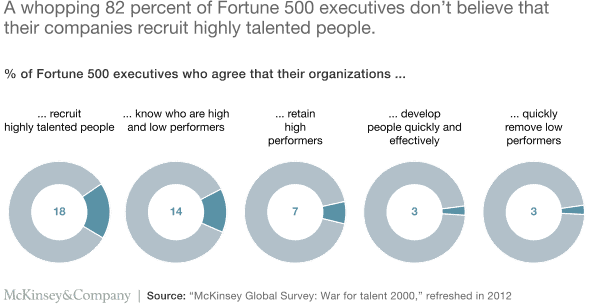How can organizations better prepare for what’s coming?
Organizations should embrace a more expansive and dynamic view of their talent supply—one that tosses out the usual preoccupation with titles and traditional roles and looks instead at the underlying skills people have. Indeed, we find that when companies start with skills—the ones they need, the ones they have, and how the mix may change over time—they can free up their thinking and find more creative ways to meet the inevitable mismatches.
In the book Leading Organizations, McKinsey senior partners Scott Keller and Mary Meaney address the most basic issues facing leaders: attracting and retaining talent, developing the talent you have, managing performance, creating leadership teams, making decisions, reorganizing to capture value quickly, reducing overhead costs for the long term, making culture a competitive advantage, leading transformational change, and transitioning to new leadership roles.
Why is talent important?
Management guru Jim Collins concurred: “… the single biggest constraint on the success of my organization is the ability to get and to hang on to enough of the right people.”
The late Steve Jobs of Apple summed up talent’s importance with this advice: “Go after the cream of the cream. A small team of A+ players can run circles around a giant team of B and C players.”
A recent study, called „THE BEST AND THE REST: REVISITING THE NORM OF NORMALITY OF INDIVIDUAL PERFORMANCE“ conducted by Ernest O’Boyel Jr. and Herman Aguinis found that 10% of productivity comes from the top 1% of employees and 26% of output is a product of the top 5%.

How to match talents with value to let the top 5% generate the highest value for the organization? Apple started with identifying the top five percent of their employees. With Apple’s share price having steadily risen since then, it appears that Steve Jobs was right. Successful companies recognize that getting the right talent in the right place can make or break their overall performance.
Once the 5 percent of roles that create 95 percent of the value are identified, the question becomes whether your most talented people are in these roles. We rarely find that the best leaders in the company are methodically deployed as such. Further, keeping the right talent in these roles typically requires significant adjustments to job design (removing administrative burdens), career paths (rapid advancement opportunities and special projects), compensation (above market), location (high flexibility), development (high touch beyond formal programs and the formal performance management process), leadership exposure and influence (more, sooner) and the like.
Citations from McKinsey Business Insights | 2017 – 2020


Fehlerbericht
Der folgende Text wird anonym an den Autor des Artikels gesendet: